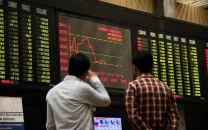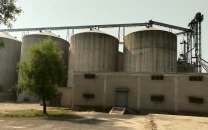Policy rate left unchanged
SBP expects inflation to come under control with easing global commodity prices

In line with market expectations, the central bank on Monday left its key policy rate unchanged at 15% for the next seven weeks with the outlook the ongoing ease in global commodity prices should control inflation and moderate the current account deficit in the country.
Curtailing high inflation and the widening current account deficit have remained the two primary objectives of the State Bank of Pakistan’s (SBP) monetary policy statement for the past several months.
The SBP, in its monetary policy statement, said “to cool the overheating economy (high inflation) and contain the current account deficit, the policy rate has been raised by a cumulative 800 basis points since last September (in the past 11 months), some temporary administrative steps have recently been taken to curtail imports, and strong fiscal consolidation is planned for FY23.”
These actions are expected to work their way through the system over the coming months. With recent inflation developments in line with expectations, domestic demand beginning to moderate, and external position showing some improvement, “the MPC (Monetary Policy Committee) felt that it was prudent to take a pause (in rate hike cycle) at this stage.”
Earlier, the economy had overheated with the second highest current account deficit at $17.4 billion in the previous fiscal year, and inflation at a 14-year high at around 25% in July 2022.
Oil prices have continued to decline in international markets and are hovering below $100 per barrel these days compared to over $130 around March 2022 in the backdrop of the Russia-Ukraine conflict that erupted in February 2022.
The share of energy stood at around 25% in the total import bill of $80 billion in FY22. It, however, fell significantly amid a drop in global prices and corrective measures taken by the government.
Secondly, the spike in inflation had come mainly due to the withdrawal of subsidies on energy products to win back the IMF loan programme. Inflation may further rise in the coming months. “Looking ahead, the MPC intends to remain data dependent, paying close attention to month-on-month inflation, inflation expectations, developments on the fiscal and external fronts, as well as global commodity prices and interest rate decisions by major central banks,” the SBP said.
In contrast to the trend since last summer, more emerging market central banks have started to hold policy rates in their recent meetings. “This suggests that globally, risks may be shifting slightly from inflation toward growth, although this remains highly uncertain at this stage,” it said.
On balance, the MPC noted that some greater slowdown in global growth would not be as harmful to Pakistan as for most other emerging economies, given the relatively small share of exports and foreign private inflows in the economy. “As a result, both inflation and the current account deficit should fall as global commodity prices ease, while growth would not be as badly affected.”
MPC noted the trade balance fell sharply in July and the rupee reversed course against the US dollar during August, appreciating by around 10% on improved fundamentals and sentiment. Moreover, the board meeting on the ongoing review under the IMF programme will take place on August 29 and is expected to release a further tranche of $1.2 billion, as well as catalyse financing from multilateral and bilateral lenders. “In addition, Pakistan has also successfully secured an additional $4 billion from friendly countries over and above its external financing needs in FY23. As a result, FX reserves will be further augmented through the course of the year, helping to reduce external vulnerability,” it said.
GDP likely to rise 2-3%
As expected, economic activity has moderated since the last MPC. Most demand indicators have softened—sales of cement, POL, fertilisers and automobiles fell month-on-month in July—and year-on-year growth in LSM almost halved in June.
Recent flooding caused by unusually heavy and prolonged monsoon rains creates downside risks for agricultural production, especially cotton and seasonal crops, and could weigh on growth this year.
Looking ahead, the MPC continues to expect growth to moderate to 3-4% in FY23, on account of the tightening of fiscal and monetary policies. This will ease demand-side pressures on inflation and the current account and lay the ground for higher growth in the future on a more sustainable basis.
After widening significantly in June, the trade deficit halved to $2.7 billion last month, as energy imports declined significantly and non-energy imports continued to moderate. Remittances remained strong. As a result of these better current account developments and improved sentiment due to diminished uncertainty about the IMF program, the Rupee recovered in August.
Published in The Express Tribune, August 23rd, 2022.
Like Business on Facebook, follow @TribuneBiz on Twitter to stay informed and join in the conversation.



















COMMENTS
Comments are moderated and generally will be posted if they are on-topic and not abusive.
For more information, please see our Comments FAQ